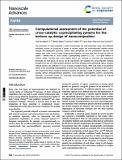Por favor, use este identificador para citar o enlazar a este item:
http://hdl.handle.net/10261/342774COMPARTIR / EXPORTAR:
 SHARE
BASE SHARE
BASE
|
|
| Visualizar otros formatos: MARC | Dublin Core | RDF | ORE | MODS | METS | DIDL | DATACITE | |

| Título: | Computational assessment of the potential of cross-catalytic coprecipitating systems for the bottom-up design of nanocomposites |
Autor: | Rouillard, Joti; Maier, Britta; Cölfen, Helmut; García-Ruiz, Juan Manuel | Palabras clave: | Coprecipitation Silica Textures Biomorphs Bottom-up design Catalyse Catalytic effects Chemical systems Computational approach Materials design Precipitation reaction Self-organization process Simple++ Nanocomposites |
Fecha de publicación: | 27-sep-2023 | Editor: | Royal Society of Chemistry (UK) | Citación: | Nanoscale Advances 5: 6148-6154 (2023) | Resumen: | The production of nanocomposites is often economically and environmentally costly. Silica-witherite biomorphs, known for producing a wealth of life-like shapes, are nanocomposites entirely formed through self-organization processes. Behind these precipitates are two precipitation reactions that catalyze each other. Using a simple computational approach, we show here that this type of chemical system - defined here as Cross-Catalytic Coprecipitating Systems (CCCSs) - is of great interest to material design. Provided that cross-catalytic effects are sufficient to overcome the precipitation thresholds for each phase, all CCCSs can be expected to self-organize into nanocomposite materials through a one-pot, one-step synthesis protocol. Symmetry-breaking events generating various complex, ordered textures are predicted in CCCSs involving crystalline phases. While high levels of stochasticity lead to a loss of ordering, coprecipitation is found to be robust to diffusion or advection in the solution. This model shows that a couple of chemical reactions can generate a range of complex textures - with possibly distinct physical/chemical properties. Cross-catalytic coprecipitating systems consequently represent a promising avenue for producing nanocomposites with complex textures at reduced economic and environmental costs. | Versión del editor: | http://dx.doi.org/10.1039/d3na00271c | URI: | http://hdl.handle.net/10261/342774 | Identificadores: | doi: 10.1039/d3na00271c issn: 2516-0230 |
| Aparece en las colecciones: | (IACT) Artículos |
Ficheros en este ítem:
| Fichero | Descripción | Tamaño | Formato | |
|---|---|---|---|---|
| 2023_NanoscaleAdvances_5_6148.pdf | 1,37 MB | Adobe PDF |  Visualizar/Abrir |
CORE Recommender
Este item está licenciado bajo una Licencia Creative Commons

